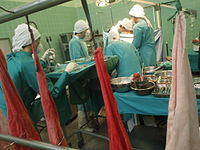
Photo from wikipedia
Introduction In primary hyperoxaluria type 1 (PH1), oxalate overproduction frequently causes kidney stones, nephrocalcinosis, and kidney failure. As PH1 is caused by a congenital liver enzyme defect, combined liver–kidney transplantation… Click to show full abstract
Introduction In primary hyperoxaluria type 1 (PH1), oxalate overproduction frequently causes kidney stones, nephrocalcinosis, and kidney failure. As PH1 is caused by a congenital liver enzyme defect, combined liver–kidney transplantation (CLKT) has been recommended in patients with kidney failure. Nevertheless, systematic analyses on long-term transplantation outcomes are scarce. The merits of a sequential over combined procedure regarding kidney graft survival remain unclear as is the place of isolated kidney transplantation (KT) for patients with vitamin B6-responsive genotypes. Methods We used the OxalEurope registry for retrospective analyses of patients with PH1 who underwent transplantation. Analyses of crude Kaplan–Meier survival curves and adjusted relative hazards from the Cox proportional hazards model were performed. Results A total of 267 patients with PH1 underwent transplantation between 1978 and 2019. Data of 244 patients (159 CLKTs, 48 isolated KTs, 37 sequential liver–KTs [SLKTs]) were eligible for comparative analyses. Comparing CLKTs with isolated KTs, adjusted mortality was similar in patients with B6-unresponsive genotypes but lower after isolated KT in patients with B6-responsive genotypes (adjusted hazard ratio 0.07, 95% CI: 0.01–0.75, P = 0.028). CLKT yielded higher adjusted event-free survival and death-censored kidney graft survival in patients with B6-unresponsive genotypes (P = 0.025, P < 0.001) but not in patients with B6-responsive genotypes (P = 0.145, P = 0.421). Outcomes for 159 combined procedures versus 37 sequential procedures were comparable. There were 12 patients who underwent pre-emptive liver transplantation (PLT) with poor outcomes. Conclusion The CLKT or SLKT remains the preferred transplantation modality in patients with PH1 with B6-unresponsive genotypes, but isolated KT could be an alternative approach in patients with B6-responsive genotypes.
Journal Title: Kidney International Reports
Year Published: 2022
Link to full text (if available)
Share on Social Media: Sign Up to like & get
recommendations!